Editorial

Welcome to July 2003 and a very "Happy Fourth" to all US readers! This month marks the first anniversary of the "monthly editorial ramblings" format, and you'll all be pleased to know that numbers are growing. The hit counter reading when last month's editorial was posted on June 3 (Oz time) was 62538. As this update was posted on July 1, the counter stood at 66665 (the neighbor of the beast) for a grand total of 4127 home page hits for the month; not big by some standards, but enough for me and I'm pleased that so many are finding something of worth in these pages—and no, I am ABSOLUTELY not building up numbers in preparation to trying to make a buck out of this site! It's like the
Motor Boys Book; the fun quotient is inversely proportional to the commercial imperative factor—so if the latter is zero, the former must be infinite, right?
Now the bad news: more cool software built during long hours left little energy for anything but a spot of reading, so most of whatever spare time I found this month was spent in the library, not the workshop. Some minor work was done on the Bambi restoration, and I did research it quite extensively as you'll see in the new Bambi page, so not a total loss. Still, the reading this month was very good indeed, but first, some news of minor revisions to this site.
New Page for Suppliers
If you do not see an entry for Suppliers in the navigation bar on the left-hand side of you screen, please execute whatever passes for the "reload" function on your particular web browser. Since I've found myself continually having to hunt around for wherever it is that I've listed sources for supply of engine-related stuff, it seemed life could be made easier if a single, well-known page contained ALL the references. And since the "What's New?" page has ceased to be maintained (per new Editorial Policy when these monthly updates were commenced one year ago), that page has been removed from the Navigation Bar, although it still exists to satisfy any internal links I don't know exist, or have forgotten about. I also vow never to use a "productivity tool" to create a web page ever again. If the suppliers page looks scruffy, that's because it was created by a well known spread-sheet program instead of my usual raw HTML. I'll fix it up progressively... promise... (and I did! The Suppliers Page is now generated from XML data and automatically cross-referenced six ways to Sunday! —Ed. May, 2007)
It should not be necessary to say (but I will anyway  ) that I have no commercial connection with any of the individuals or companies listed. In fact, and without mentioning names, one of them has earned top billing on my Permanent Poo-list! But they are all valuable as single source suppliers for scarce resources and I welcome suggestions regarding additions and amendments. I also welcome graft, but suspect I shall receive, as usual, not a sausage...
) that I have no commercial connection with any of the individuals or companies listed. In fact, and without mentioning names, one of them has earned top billing on my Permanent Poo-list! But they are all valuable as single source suppliers for scarce resources and I welcome suggestions regarding additions and amendments. I also welcome graft, but suspect I shall receive, as usual, not a sausage...
New Books and Magazines this Month

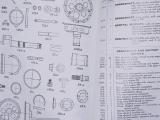 This is a slim volume, comprising cut-away drawings, descriptions, and illustrated parts lists for the Clerget rotary aero engines, models 9B-130-Horse and 9BF-150-Horse. These were originally printed separately in 1917 by Gwynnes Ltd, one of the UK licensees of the Clerget (which powered the Sopwith Camel, amongst other types). They have been combined and reprinted here by Camden Miniature Steam Services, 2001, ISBN 0-95366523-1-9. The first section (26 pages) gives a general description of the engines and subsystems with sectioned drawings and part numbers. Brief but clearly written paragraphs describe the major subsystems, disassembly sequences, things to watch out for, and provide advice on setting up the timing and other settings. The second section (17 page numbers, but 32 actual pages—it's complicated...) provides an illustrated list of all the parts numbered per the sectioned drawings, with an index that's helpful in locating the page a part is illustrated on. Also included are special tools required for working on the engine. Although the drawings in this second section are not dimensioned 3-views, and are not drawn to a common scale, they appear adequate for modelling purposes—more on that later.
This is a slim volume, comprising cut-away drawings, descriptions, and illustrated parts lists for the Clerget rotary aero engines, models 9B-130-Horse and 9BF-150-Horse. These were originally printed separately in 1917 by Gwynnes Ltd, one of the UK licensees of the Clerget (which powered the Sopwith Camel, amongst other types). They have been combined and reprinted here by Camden Miniature Steam Services, 2001, ISBN 0-95366523-1-9. The first section (26 pages) gives a general description of the engines and subsystems with sectioned drawings and part numbers. Brief but clearly written paragraphs describe the major subsystems, disassembly sequences, things to watch out for, and provide advice on setting up the timing and other settings. The second section (17 page numbers, but 32 actual pages—it's complicated...) provides an illustrated list of all the parts numbered per the sectioned drawings, with an index that's helpful in locating the page a part is illustrated on. Also included are special tools required for working on the engine. Although the drawings in this second section are not dimensioned 3-views, and are not drawn to a common scale, they appear adequate for modelling purposes—more on that later.
If you are curious about this vanished breed of engine, you will love this book. The Clerget has features I've not seen on other rotary engines. For example, the rocker arms are true rocker arms. Their pivot hole is oval with a depression at the bottom. The pivot pin is sort of egg-shaped with the pointy bit oriented towards the cylinder. The rocker then actually rocks back and forth using the depression and pin peak as a fulcrum. Why? Beat's the hell 'outa me, lieutenant... only reason I can think of is to try to keep the mass on the valve end of the rocker centered over the valve stem. Another unusual feature is the fuel system. While it has the usual, stop-cock controlled feed pipe dribbling raw fuel into the bottom of the spinning transfer spider from a pressurized fuel tank, per Le Rhone and Gnome, it also has a needle metered carburetor (of sorts) on the end of the air inlet like the Bentley BR2 (designed by WO Bentley from his experience improving the power and reliability of the Clerget, by the way). Add to this a starting crank handle that must have sat in the region of the pilot's left knee-cap. The idea was to push it forward against a spring to engage with a helically cut gear on the back of the crankcase, then "switches on" and start winding. When the engine fires, the gear is thrown out of engagement and kept that way by the spring! Dunno about Snoopy, but that would make me about as nervous as the prop-shaft between the legs arrangement of the P39.
While it's unfortunate that the individual parts are drawn to differing scales, I'd go so far as to say that an experienced model engine builder would need no other reference than this book to produce a working scale model with a high degree of fidelity. Scans could easily be scaled in CAD to fit each other then traced over. Camden has inserted a number of blue lined "graph-paper" style sheets after each section, perhaps for you to make you own notes, or perhaps (call me an old cynic) to pad the number of pages out enough for the book binding to work! I ordered my copy through Plough Book Sales in Oz for the princely sum of A$36.60 including postage and I'm very pleased with the purchase. In the USA, try Amazon Books, or if you are in the UK, go directly to the source at camdenmin.co.uk.
Rolls Royce Merlin V-12 Models
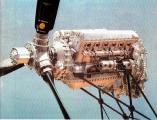 One email last month asked if I knew of any sources of construction plans for working scale models of the Rolls-Royce "Merlin" V-12. From my limited knowledge, the first that leaps to mind is Barrington Hares' well known one-fifth scale model, pictured here at the left (yes Mavis, it's a model!) This masterpiece won the Gold Medal and Cup at the 1982 Model Engineering Exhibition (hope I got that right—somebody please correct me). It features an operational Rotol controllable pitch prop, working dual magnetos (no mean feat at this scale), and correctly functioning systems with the exception of the boost control unit. The latter was not seen as required as the supercharger, at this size, does little more than atomize the fuel. It comprises 7000 individual components, has 60 ball and roller races, and was machined from 75 lb (34 kilo) of aluminum in a mere 6000 hours. As far as I know, no plans were ever published for Barrie's Merlin, but there exist at least two other sources.
One email last month asked if I knew of any sources of construction plans for working scale models of the Rolls-Royce "Merlin" V-12. From my limited knowledge, the first that leaps to mind is Barrington Hares' well known one-fifth scale model, pictured here at the left (yes Mavis, it's a model!) This masterpiece won the Gold Medal and Cup at the 1982 Model Engineering Exhibition (hope I got that right—somebody please correct me). It features an operational Rotol controllable pitch prop, working dual magnetos (no mean feat at this scale), and correctly functioning systems with the exception of the boost control unit. The latter was not seen as required as the supercharger, at this size, does little more than atomize the fuel. It comprises 7000 individual components, has 60 ball and roller races, and was machined from 75 lb (34 kilo) of aluminum in a mere 6000 hours. As far as I know, no plans were ever published for Barrie's Merlin, but there exist at least two other sources.
First, there is a Swedish supplier who advertises in Engine Collectors Journal. His model of the Wright J-5 Whirlwind (the radial used by Ryan in Lindberg's Spirit of St Louis) appeared in SIC several years back and you can still obtain castings and plans for it from him. New to his list though is a plan set for a 1:5 scale Merlin. This will set you back 700 kroner which is about US$90 at today's exchange rate. I've no other detail available than that; are casting required, or available? Dunno—ask him, but remember, Barrie Hares hogged his masterpiece from solid.

The second has been around a while. At the first Pacific Rim Model Engineering show (PRIME) in Eugene Oregon, I saw examples of a quarter scale RR Merlin replica being built by a number of different individuals from a casting/plan set that was than incomplete, but growing over time. One of the builders told me that the designer eventually wanted to make ready-to run engines for the scale R/C model market (deep pockets!) and to finance the start-up, he was selling casting kits. When he had enough, the kits would be withdrawn from the market and only "production" engines would be sold. I though from this that the boat had already sailed, but Bert Streigler forwarded me this very informative link to Dynamotive and this appears to be the same source as the excellent parts I saw in 1997.
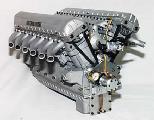
The engine is not 100% scale, but most of the deviations are hidden away—apart from one that no self-respecting purist could live with. Even at 1/4 scale, the parts for twin overhead cams, driven by bevel gears and angled torque rods would be a challenge to anyone less than the remarkable Mr Hares mentioned earlier. So the designer decided to use just two valves per cylinder, and a single cam shaft driven by a toothed timing belt. This is glaringly obvious in the rear end photo shown here. The utility of this approach cannot be denied; if you want a running engine to fly a model, this is the way to go. If you want a running, museum-quality, show-case engine, it looks like the design could be modified to emulate RR's drive, while retaining the (hidden) single overhead cam shaft.
A set of casting and CAD drawings for this engine is going to set you back about US$3K—more if you decide to buy a set of valves and NC cut rockers (24), and fit the optional supercharger. Not cheap, but good value based on the drawing samples viewable on the website, and from what I remember of the castings quality (investments, I think) that I saw at PRIME. And besides, the finished, running engine would be worth a hell of a lot more, if you were prepared to part with it!
Aero Engine Kits
I've held a private pilot's license since 1968 and have been a member of the Experimental Aircraft Association for almost the same period. The EAA champions homebuilt aircraft, classic and warbird restorations, plus a host of other activities. Each month they publish a thick glossy magazine that goes out to all members, plus a number of cost-extra specialized magazines. Since "Sport Aviation" (the EAA magazine) is not model engine, nor model engineering related, I don't mention it here, but in the last year or so, I've been noticing an increase in the number of complete-to-the-last-nut-and-bolt aero engine kits being made available. I'll mention two from opposite ends of the scale.
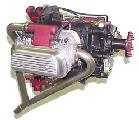
First is John Monett's AeroVee 2002. This is basically the venerable vee-dub flat four that homebuilders have been using as an alternate to certified aero engines for longer than I've been associated with the movement. However, the AeroVee has some very significant differences in the area of ignition, carburetion and reciprocating parts that significantly improve the reliability and flexibility of the engine. Years ago, a builder I knew finished and flew a design once called the "Volksplane" (VW made the designer change that title though—spoil sports that they are). Having aero-ized a stock vee-dub engine for his aircraft, he was so familiar with it's capabilities that he was never brave enough to fly the plane out of gliding distance from the runway! By the look of it, Monett's adaptation would alleviate all such worries. So for around US$5K, you and your torque wrench can assemble a reliable engine for that man, err... person-carrying model.

At the other end of the scale is the XP-360. This is a Lycoming based flat-four, available ready to bolt on for about US$20K, or ready to bolt together for US$16.5K. Like the AeroVee, it uses the basic crankcase of its ancestor, with modifications, but replaces just about everything else with after-market parts that are equal, or just a little bit better than what you'd get if you bought a stock Lycoming 0-360. Now you can argue that any engine assembled in a specialized plant with over 50 years of experience in the type is going to be superior to one assembled in your average two car garage, regardless of the components used. I think the advantage obtained from kit engines are of most significance to the US homebuilt regulations where, as the original builder, you obtain a workman's certificate that enables you to do your own regular, required inspections and maintenance on power plant and airframe—significantly reducing the cost of ownership. Oz builders are not so lucky. Don't matter none that YOU built the engine, it's got to go to a LAME (Licensed Aircraft Maintenance Engineer) for inspections. Bring shekels; bring LOTS of shekels. Are US skies less safe because of this? The evidence suggests not, but moving any entrenched bureaucracy is a non-trivial task. I'll get off my soap-box now and return to model engines...
New Engines in the Finder for July
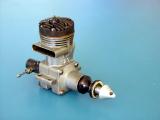 In February 1961, I arrived at the Brisbane Boy's Grammar School as the lowest form of life: a "third form-er" and immediately joined the Air Force Cadets, known then as the Air Training Corps (ATC). As reward for this patriotic act, we new recruits were given into the care of one corporal Smith, a fourth form cadet Drill Instructor (DI), and expert in the art of intimidation and advanced haranguing. Things went better after I found out that he too made model planes and we've remained close friends ever since. The next year (1962), saw the manufacture of a particular ETA 29 racing glow plug engine that is now in Van's collection—arriving after he'd graduated and was earning money in the broadcast radio game (we won't mention the dodge he pulled to import the engine without all the customs duty and sales tax, shall we Van?—though I doubt the national economy was endangered by this heinous, criminal act
In February 1961, I arrived at the Brisbane Boy's Grammar School as the lowest form of life: a "third form-er" and immediately joined the Air Force Cadets, known then as the Air Training Corps (ATC). As reward for this patriotic act, we new recruits were given into the care of one corporal Smith, a fourth form cadet Drill Instructor (DI), and expert in the art of intimidation and advanced haranguing. Things went better after I found out that he too made model planes and we've remained close friends ever since. The next year (1962), saw the manufacture of a particular ETA 29 racing glow plug engine that is now in Van's collection—arriving after he'd graduated and was earning money in the broadcast radio game (we won't mention the dodge he pulled to import the engine without all the customs duty and sales tax, shall we Van?—though I doubt the national economy was endangered by this heinous, criminal act  ). The ETA 29 was the engine for B Class Team Racing here and in Britain during the 60's and like the Dooling 29, is a sought-after collectable today. Van's example, LNIB, has been added to the Engine Finder this month.
). The ETA 29 was the engine for B Class Team Racing here and in Britain during the 60's and like the Dooling 29, is a sought-after collectable today. Van's example, LNIB, has been added to the Engine Finder this month.
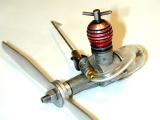
To make up for slackness in the shop last month, I've done some research into the history of the Davies-Charlton Bambi, aka the Allbon Bambi, which it never was. And if that's confusing, you need to read about it for yourself on the new Bambi Page, also accessible through the Engine Finder. As mentioned briefly last month, this is the little 3/4 oz (20 gm) engine that was obtained in trade for one of the 11-7/8 oz (335 gm) Sparey 5cc diesels I made when the weather here was warmer (note lame excuse for lack of progress in the unheated shop during a Brisbane winter when the temperature sometimes drops as low as 10 degrees Celsius in the wee hours of the morning; burrr... and well you may laugh!)
Index to Model Engine Tests
While Googling for ETAs, Van Richards-Smith (the feared cpl Smith mentioned earlier) has found a very diverse aeromodeling web site containing an Index to Model Engines Tests published in English and American magazines. This is the work of Terry McDonald and having once started such a project and totally failed to finish it, I must applaud Terry for the effort he has poured into this page. If he actually has every magazine referenced, I'm also green with envy! The page appears as part of Dave Day's aeromodeling site which has pictures of two beautiful vintage and classic stunters at the top, to wit: A Nobler and an Argus (the fore-runner to the Ares). Check it out...
 Editorial
Editorial
 New Books and Magazines This Month
New Books and Magazines This Month
 Engine Of The Month (1): Eta 29
Engine Of The Month (1): Eta 29
 Engine Of The Month (2): DC Bambi
Engine Of The Month (2): DC Bambi
 Standard Stuff
Standard Stuff
![]()

 Welcome to July 2003 and a very "Happy Fourth" to all US readers! This month marks the first anniversary of the "monthly editorial ramblings" format, and you'll all be pleased to know that numbers are growing. The hit counter reading when last month's editorial was posted on June 3 (Oz time) was 62538. As this update was posted on July 1, the counter stood at 66665 (the neighbor of the beast) for a grand total of 4127 home page hits for the month; not big by some standards, but enough for me and I'm pleased that so many are finding something of worth in these pages—and no, I am ABSOLUTELY not building up numbers in preparation to trying to make a buck out of this site! It's like the
Welcome to July 2003 and a very "Happy Fourth" to all US readers! This month marks the first anniversary of the "monthly editorial ramblings" format, and you'll all be pleased to know that numbers are growing. The hit counter reading when last month's editorial was posted on June 3 (Oz time) was 62538. As this update was posted on July 1, the counter stood at 66665 (the neighbor of the beast) for a grand total of 4127 home page hits for the month; not big by some standards, but enough for me and I'm pleased that so many are finding something of worth in these pages—and no, I am ABSOLUTELY not building up numbers in preparation to trying to make a buck out of this site! It's like the  ) that I have no commercial connection with any of the individuals or companies listed. In fact, and without mentioning names, one of them has earned top billing on my Permanent Poo-list! But they are all valuable as single source suppliers for scarce resources and I welcome suggestions regarding additions and amendments. I also welcome graft, but suspect I shall receive, as usual, not a sausage...
) that I have no commercial connection with any of the individuals or companies listed. In fact, and without mentioning names, one of them has earned top billing on my Permanent Poo-list! But they are all valuable as single source suppliers for scarce resources and I welcome suggestions regarding additions and amendments. I also welcome graft, but suspect I shall receive, as usual, not a sausage...


 One email last month asked if I knew of any sources of construction plans for working scale models of the Rolls-Royce "Merlin" V-12. From my limited knowledge, the first that leaps to mind is Barrington Hares' well known one-fifth scale model, pictured here at the left (yes Mavis, it's a model!) This masterpiece won the Gold Medal and Cup at the 1982 Model Engineering Exhibition (hope I got that right—somebody please correct me). It features an operational Rotol controllable pitch prop, working dual magnetos (no mean feat at this scale), and correctly functioning systems with the exception of the boost control unit. The latter was not seen as required as the supercharger, at this size, does little more than atomize the fuel. It comprises 7000 individual components, has 60 ball and roller races, and was machined from 75 lb (34 kilo) of aluminum in a mere 6000 hours. As far as I know, no plans were ever published for Barrie's Merlin, but there exist at least two other sources.
One email last month asked if I knew of any sources of construction plans for working scale models of the Rolls-Royce "Merlin" V-12. From my limited knowledge, the first that leaps to mind is Barrington Hares' well known one-fifth scale model, pictured here at the left (yes Mavis, it's a model!) This masterpiece won the Gold Medal and Cup at the 1982 Model Engineering Exhibition (hope I got that right—somebody please correct me). It features an operational Rotol controllable pitch prop, working dual magnetos (no mean feat at this scale), and correctly functioning systems with the exception of the boost control unit. The latter was not seen as required as the supercharger, at this size, does little more than atomize the fuel. It comprises 7000 individual components, has 60 ball and roller races, and was machined from 75 lb (34 kilo) of aluminum in a mere 6000 hours. As far as I know, no plans were ever published for Barrie's Merlin, but there exist at least two other sources.





